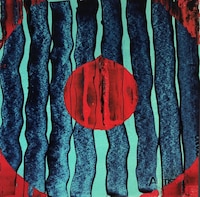Sign in
A hard-edged, single-color ring holds the center of nearly every picture in Marylyn Dintenfass’s “Never Lose the Blues,” but these geometric archetypes are surrounded by and submerged in soft, organic forms. The juxtaposition makes the artist’s color-field paintings simultaneously fast and slow; their impact is immediate, but they encourage and reward extended perusal. Displayed in the home of art adviser Cheryl Numark, who ran downtown’s Numark Gallery from 1995 to 2006, the canvases seem to offer near-infinite variations on a theme.
Although Dintenfass is a New Yorker, her paintings have an affinity with the work of Washington’s mid-20th-century colorists. Unlike them, she uses oils rather than acrylics, but she produces seemingly liquid hues that appear to flow over, under and within the central circles. Many of these pictures are from a series titled “Oculus,” and some do resemble close-ups of irises dappled with reflected light. Others suggest cells or microbial life forms, teeming under a microscope. Only some of the hues, however, evoke nature. When Dintenfass loses the blues, her colors can be as hot and bright as pulsing neon signs.
Also on exhibit are two paintings from the artist’s “Drop Dead Gorgeous” sequence, whose inspiration is specifically botanical: Angel’s Trumpets, flowers that when consumed elicit strong hallucinations. Among the show’s principal series are a few deviations: pictures with multiple soft-edged rings, and another whose central roundel is overlapped by another, off-kilter one. The effect is especially vivid, but even Dintenfass’s symmetrical paintings have a certain drama. Their dominant shapes are pristine and eternal, but those perfect circles are lapped by blobs, blotches and squiggles that represent a cosmos in constant flux.
Marilyn Dintenfass: Never Lose the Blues Through Jan. 29 at Numark Art Advisory, 4726 Linnean Ave. NW. Open by appointment.
The seven-artist show at Brentwood Arts Exchange includes some found objects, but also traces of things lost. “Here Not Here” means to conjure “the enduring imprint of the past on the present,” according to the gallery.
Two of the participants transfigure their own work. Kanchan Balsé slaps thick white pigment atop multicolor canvases, leaving people- and tree-shaped windows through which viewers can glimpse the overpainted pictures below. Maggie Gourlay pulps old screen prints and forms the residues into target-like rounds whose faintly hued, single-color circles she calls “growth rings.”
Several of the artists order the unruly world by arranging items in grids. Caroline MacKinnon fills a set of wooden cubbyholes with shells, feathers and seed pods as well as ceramic discs of her own making. Louisa Neill hangs shadow-casting photographic transparencies, mostly of architectural details, inside two sets of small, white boxes. Less tightly compartmentalized is Rebecca Perez’s set of pictures, rendered impressionistically in ink and paint, of damaged but healing human hearts.
Flickering video images add to the sense of transience in pieces by Shelley Picot and Pixie Alexander. Picot uses an animated dog and cryptic text to deliver private musings. In Alexander’s video, one of three works that employ old dresses, superimposed figures dance and try on clothes. The traces evoked here are not just of missing stuff, but also of absent people, embodied by clothing they used to wear.
Here Not Here Through Jan. 21 at Brentwood Arts Exchange, 3901 Rhode Island Ave., Brentwood.
Digital artworks authenticated by NFTs (non-fungible tokens) have lost much of their value since the trend’s peak just a few years ago, so this might not seem the best moment for Addison/Ripley Fine Art to enter the market. But the gallery’s “Art + NFT” exhibition offers actual, not virtual, objects. The 20 NFT-linked pieces will still exist even if the entire cyberverse vaporizes.
The featured artists are mostly ones who exhibit often at Addison/Ripley, such as painters Carol Brown Goldberg, Trevor Young and Christopher Baer, as well as photographer Frank Hallam Day. Of the works by members of this group, among the most striking are Nan Montgomery’s “Orb,” an abstraction whose minimalist geometric design is juiced by rich colors; Dan Treado’s “Ohm Sweet Ohm,” whose ominous overlapping skulls are rendered in tranquil pastels; and Yuriko Yamaguchi’s “Cloud #2,” which scatters resin petals, also pastel-hued, amid a steel-wire nest.
The contributions by Addison/Ripley irregulars include a black-and-white target by Helen Zughaib, who infiltrates the methodical circles with minuscule calligraphy; a sailboat conjured by Micheline Klagsbrun from a curve of whitened driftwood and a triangle of handmade paper; and a mixed-media picture by Martha Jackson-Jarvis. The last is an ecstatic mix of painted swoops, raked with patterns, and inky drips. Its earthy colors and subtle textures have to be appreciated IRL, not even via the highest-definition digital display.
Art + NFT Through Jan. 21 at Addison/Ripley Fine Art, 1670 Wisconsin Ave. NW.
A longtime contributor to National Geographic, Jonathan Alderfer depicts birds with scientific precision but also empathetic yearning. The Watergate Gallery show of the Maine-based former Washingtonian surveys his paintings, drawings and prints, all avian-themed but quite different in style and intent.
Many of the pictures are near-photographic renderings made for guides to North American birds. These watercolor-and-gouache illustrations often portray the creatures alone or in pairs on white backdrops, sometimes with hints of sky, sea or grass. The subjects include a bald eagle in flight, multiple breeds of puffins, and a wall of hummingbirds and other tiny birds, many with shimmering green plumage.
Alderfer takes a slightly more impressionistic approach in ink, pencil or crayon drawings, one of which depicts turnstones in profusion among oyster shells on the Eastern Shore. Another of the rare pictures that specifies a location is a dramatically silhouetted painting of the Potomac River near Key Bridge, where black rocks and blue water conceal a great blue heron. The setting also nearly upstages the bird in a painting of a kestrel perched on a finial atop an ornate building. This structure is the show’s sole acknowledgment of human presence in a universe of free birds.
Jonathan Alderfer: Paintings, Drawings, Prints Through Jan. 28 at Watergate Gallery, 2552 Virginia Ave. NW.

